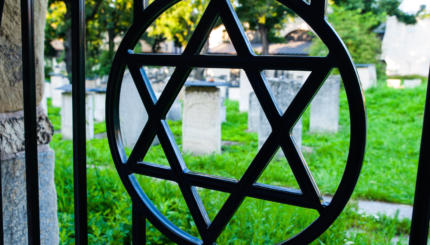Although the most vital tasks and decisions must be made by family members, an excellent way to deal with other tasks is to recruit as many friends and non-first-degree relatives (in-laws can be excellent for this) as possible to make phone calls, help transport out-of-town relatives, arrange food for the meal following the funeral, and assist with other needed errands. In addition, if you or the deceased was a member of a synagogue, there is a good chance that congregation has a group of volunteers available to help with the funeral, and meal of consolation. Find a shiva planning checklist here.
Note: We have not included details about cremation, as it is not a traditional Jewish practice. However, many American Jewish families opt for cremation, and most funeral homes can assist with making cremation arrangements. Learn more about Jewish views on cremation here.
Did we forget anything? Let us know in the comments below, or email us at community@myjewishlearning.com.
Burial Arrangements
- Contact a (Jewish burial society) and/or Jewish funeral home. If there is no local organization of this type, contact other local Jewish families, the closest synagogue or the nearest Jewish federation.
- If the departed person has a pre-arranged burial and funeral plan, find the necessary information.
- If the deceased owned a (prayer shawl), decide if they should be buried with it. (It may also be kept as a family heirloom.)
Sharing the Sadness
- Inform—in person, if possible — the closest family members. For out-of-town members of the immediate family, do your best to make sure that the person being called is not alone or in an inappropriate location to receive the sad news of their loved one’s death. (For example, one should not notify a sibling that their sister has died while he or she is on their cell phone and driving.)
- Make a list of people who should be contacted regarding the death. Include family members, friends, employers (of both the deceased and of family members), co-workers, community members and neighbors.
- Delegate family members and friends for making phone calls.
Funeral Service
- Contact the synagogue of the departed person and/or of the mourners.
- Decide who will conduct the funeral service.
- Consult with the service officiant regarding the eulogy and the participation of family members and friends.
- Estimate the number of funeral attendees.
- Consult with the funeral home and/or cemetery regarding service locations for both the eulogy and burial. Decide if a chapel and/or graveside service will suit family needs.
- Appoint pallbearers (who will carry the coffin part or all of the way to the burial site). If there are individuals who may be unable physically to handle this task, you may designate them as “honorary” pallbearers.
- Arrange for transportation to and from the ceremony for mourners and other family members. This is often done through the funeral home.
- Some mourners may wish to practice reciting the Mourner’s Kaddish prayer.
- If mourners would like to rip a garment (usually a shirt or sweater) for , then they should wear that article to the funeral (with appropriate garments underneath, for the sake of modesty).
- If children are to attend the funeral, arrange to seat them with a babysitter or other responsible adult who will not mind leaving the service if the children are restless or upset.
Seudat Havra’ah (“Meal of Consolation“)
- If the family will be observing this custom, members of the extended family or friends — but not the immediate mourners — should make arrangements for a light meal.
- Give out directions to the family home at the funeral.
- Place a pitcher of water, a basin and towel outside the front door, to be used by funeral returnees before they enter the home. (This may also be done outside the cemetery.)
- Prepare hard-boiled eggs for eating during the meal. These eggs symbolize the cyclical nature of life.
Sign up for a Journey Through Grief & Mourning: Whether you have lost a loved one recently or just want to learn the basics of Jewish mourning rituals, this 8-part email series will guide you through everything you need to know and help you feel supported and comforted at a difficult time.

Help us keep Jewish knowledge accessible to millions of people around the world.
Your donation to My Jewish Learning fuels endless journeys of Jewish discovery. With your help, My Jewish Learning can continue to provide nonstop opportunities for learning, connection and growth.
Looking for a way to say Mourner’s Kaddish in a minyan? My Jewish Learning’s daily online minyan gives mourners and others an opportunity to say Kaddish in community and learn from leading rabbis.



